We walked/hobbled into the Tourism Office and collected a city
map and advice about cafes at the light tour for tonight. We then went to a
café for a light breakfast, before going over to the most recommended place to
visit in Beaune.
The Hotel Dieu or Hospice de Beanne has a 500-year history as a
hospital, mainly for the poor. It was set up and funded by a local, and staffed
by nuns. Over the years it had other donors including people who donated an
area with vines. Other legacies have extended the vineyard and it makes very
prestigious wines sold once a year by auction which still funds a hospital,
although not on this site.
John was also happy to visit the site as it was mainly inside
and so not so hot. The audio guides were part of the entrance fee and not too
detailed, so we wandered and listened and took photos.
The hospital for the poor was set up in 1443 by the chancellor
to the Duke of Burgundy and his wife. Nicolas Rolin and his wife Guigone de
Salins had a great vision and the building was made with the finest materials,
hence has lasted all this time. The area was coming out of the 100 years’ war
and much of Beaune had been decimated. The building was for the poor and most
disadvantaged. He also provided funding for white bread to be distributed
daily.
He was a good administrator with knowledge of hospital
institutions so he placed it under the spiritual
authority of the ‘Holy See’, free from any charge, and it was mainly staffed by
nuns. The elderly, disabled, sick and destitute were welcomed, treated, fed and
also given spiritual guidance.
We started in the stunning courtyard and saw the lovely colours
of the tiles on the roofs, which is typical of the region we were told. The
outside is quite austere so the colour here is more noticeable.
We then went into the Great Hall of the Poor, which had beds on
both sides as they would have been when it was a hospital. This room had no
fireplace and the commentary said that it was cold but the beds were heated
with both pans and hot bottles. There were some parts where there was a
‘sister’ attending to a patient, dressed as she would have been through the
years. The end of this room was the chapel, although we heard the original fine
tapestries and decorations were destroyed in the past.
The next rooms did have fireplaces in them. We heard that people
who could afford it could also be cared for and paid for this. The rooms also acknowledge
the support of various people over the years who helped fund the original
purpose and allow it to be extended. The original amount Nicolas and Guigone
had donated to fund everything was not quite enough for the needs of the area
so extra donations we welcomed. They had royal support at times which helped.
One King was disturbed that men and women were treated in the same area and
gave the funds needed to separate them.
The next area showed us some of the medical items used over the
years, with comprehensive descriptions of their use. Living in the 21st century,
we have a lot to be grateful for I decided.
The pharmacy/laboratory area was interesting as well. It was
explained that the original area was much smaller and this was as it was in the
18th century from memory. The local apothecary decided that the nuns should
also be able to prepare medicines, and after training they did formulate some
of the potions. We saw a series of what we assume are empty bottles labelled as
they would have been, with the comment that earthenware was perfect to keep
items dry. There were also scales, mortar and pestle, and a very large grinder.
The kitchens are always interesting. Here it was explained that
the sisters would arise early to make bread and not finish until the evening
meal was served, the patients had a final check and the kitchen was left spotless.
From the start there were gardens to provide wheat and vegetables and a farm
for eggs, milk and meat. There was a 3 tier spit introduced later to make cooking
easier, and a hinged chain to help get heavy pots from the fires. St Martha
presided over the kitchen. We were told she is the patron saint of kitchens,
but it appears she is really the patron saint of housewives.
The final rooms told us more of the history of the hospital and
held items that were used in the past, including a number of chests used for
storage.
The area finished with details of the wine auction, before the obligatory
gift shop. In 1457, Guillemette Levernier made the first gift of vineyards to
the Hospices de Beaune, and this tradition was to continue for five centuries.
Today, the wine estate is around 60 hectares, of which 50 are devoted to Pinot
Noir and the rest to Chardonnay. Entrusted to 22 winemakers handpicked by its
manager, this exceptional vineyard accounts for 85% of premiers crus and grands
crus sold at auction on the third Sunday in November, organised by
Christies. All proceeds from the sale benefit medical treatments at the Beaune
Hospital and the maintenance of its historic listed buildings.
We walked back to the apartment by going past the main church,
the collegiate Basilica Notre-Dame de Beaune. It is one of the last great
Romanesque churches of Burgundy and Its construction was begun in the
middle of the 12th century. Service was just finishing so we did not go inside
but had enjoyed the sound of the bells. Next was the Hotel de Ville which we
took photos of before exiting the historic area via the Porte Saint Nicolas.
This is relatively new as it was replaced in 1770.We are staying in the St
Nicolas area so that put us on the path to home, with a sidestep for a
cache.
I was ready to put my foot up and we both blobbed out for a
while. I had planned a rural circuit for the afternoon but when we looked it
was a bit long. I cut it back and may have left out the best bit as we were
happy to be in the countryside, but otherwise the trip was ordinary. Hence we
defaulted into looking for a couple of caches.
The first took us to a most unexpected Roman column down a one-way
county side road. We had not been able to read the listing in French but did
pick Roman column from the title ‘La colonne Romaine roma’.
There was information in English at the site as well. The origin
of this column dates back to the third century AD. Until 1825, its height was
8.25 m. When restored under Charles X, it was surmounted by two additional
barrels and a capital. The wrought iron enclosure also dates from this
restoration. Its current height is 11.60 m.
The column was long considered a monument commemorating a victory, or even a funerary monument. The commonly accepted hypothesis at present is that of a religious monument placed at the entrance or centre to a Gallo-Roman domain. It was surmounted by a statue of a horseman (Jupiter?) slaying an angel monster. It presents deities on the 8 faces of the second pedestal: Juno and his peacock facing the entrance, Minerva and his owl, Jupiter armed with a spectre, Apollo or Ganymede, Diana accompanied by a dog, Hercules, Venus and Bacchus
The column was long considered a monument commemorating a victory, or even a funerary monument. The commonly accepted hypothesis at present is that of a religious monument placed at the entrance or centre to a Gallo-Roman domain. It was surmounted by a statue of a horseman (Jupiter?) slaying an angel monster. It presents deities on the 8 faces of the second pedestal: Juno and his peacock facing the entrance, Minerva and his owl, Jupiter armed with a spectre, Apollo or Ganymede, Diana accompanied by a dog, Hercules, Venus and Bacchus
We then went to a windmill but it was both less interesting and
we couldn’t find the cache. We then drove home via the backroads, spying a very
scrawny fox in a field.
On our return John watched the World Cup Final, while the skies
opened and we had thunder and lightning. The temperature had been 31C and
dropped to 19C.
We went to the Japanese restaurant we had spotted on the way
home and had checked out on the internet. It had a good name, but also did
takeaways, so we felt we were safe as we couldn’t book. We hadn’t counted on
the chef being sick and the whole place with a sign on the door saying they
were sorry, but closed. So we carried on into the historic areas amid the locals
going mad and screaming around hanging out of cars, celebrating the World Cup
win.
We found a place that had a space near the middle of the town.
By then I was over food so had an omelette and then dessert but John managed a
full menu. We discussed just staying on in the area to see ‘light up Beaune’,
but it was a little cooler by now and we would have had time to kill. So we
went back to the apartment and rugged up (well added a layer) and collected the
information, which I found I basically knew.
‘Light up Beaune’ runs during the summer from 10.30 pm until
midnight. 7 major buildings have a light show which proved to be more detailed
than I was expecting. I knew the Notre Dame Cathedral was meant to be good, but
we found others also had light shows displayed on them, while others were just
well lit. Our plans went a bit awry as it was after 10.30 pm when we got back.
We had intended starting at the far end and walking back but ended up doing a funny
order and not covering them all.
We saw Porte St Nicolas and the Hotel de Ville lit as we moved
into the town but what proved to be the Chapelle Saint Etienne had a lovely
series of scenes projected on to it. We went to the Hotel Dieu and saw the
familiar scenes of the beds and the pharmacy before going to the Cathedral,
which we made our last stop. If we were not getting a bit foot sore with a walk
home to face we may have visited a couple of others but I was happy with what
we had seen. We had thought we would drive into the area and walk from there
until we were put off by some of the crazy driving we had seen. But still it
was a nice way to end the day and the walk made for a sound sleep on our
return.

 Beaune, Bourgogne Franche-Comté, France
Beaune, Bourgogne Franche-Comté, France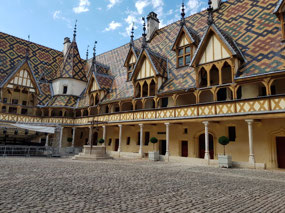
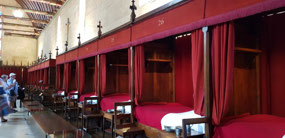
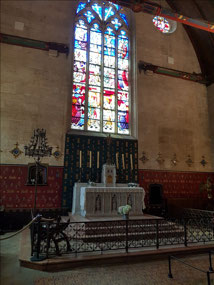
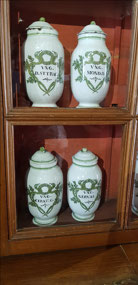
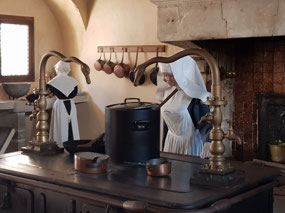
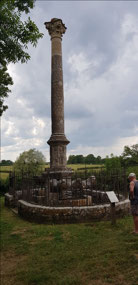
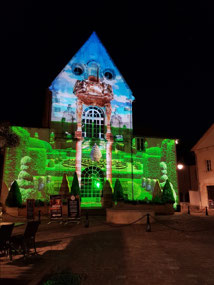
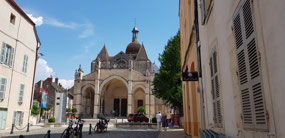
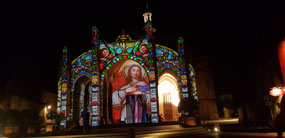









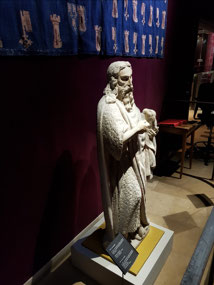
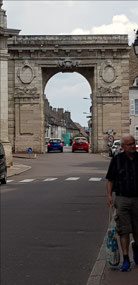
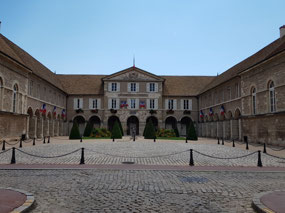
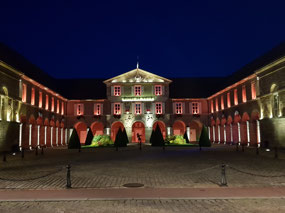
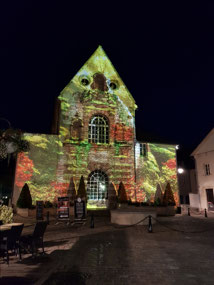
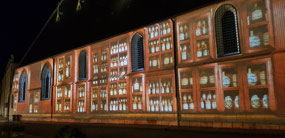
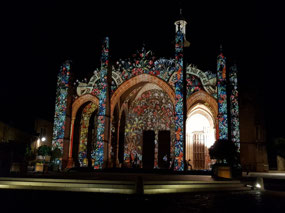
2025-05-22